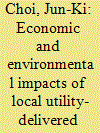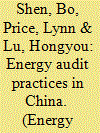|
|
|
Sort Order |
|
|
|
Items / Page
|
|
|
|
|
|
|
| Srl | Item |
| 1 |
ID:
099218


|
|
|
|
|
| Publication |
2010.
|
| Summary/Abstract |
In 2005, the Chinese government announced an ambitious goal of reducing energy consumption per unit of gross domestic product (GDP) by 20% between 2005 and 2010. One of the key initiatives for realizing this goal is the Top-1000 Energy-Consuming Enterprises program. The energy consumption of these 1000 enterprises accounted for 33% of national and 47% of industrial energy usage in 2004. Under the Top-1000 program, 2010 energy consumption targets were determined for each enterprise. The objective of this article is to evaluate the program design and initial results, given limited information and data, to understand the possible implications of its success in terms of energy and carbon dioxide emission reductions and to recommend future program modifications based on international experience with similar target-setting agreement programs. Even though the Top-1000 program was designed and implemented rapidly, it appears that - depending upon the GDP growth rate - it could contribute to somewhere between approximately 10% and 25% of the savings required to support China's efforts to meet a 20% reduction in energy use per unit of GDP by 2010.
|
|
|
|
|
|
|
|
|
|
|
|
|
|
|
|
| 2 |
ID:
090055


|
|
|
|
|
| Publication |
2009.
|
| Summary/Abstract |
The establishment of a compressed air system (CAS) best practice programme is a key component of one of the initial industrial energy efficiency programmes being driven by New Zealand government ministries and agencies. In a global context this is not a new initiative in that existing programmes have been functioning in Europe and USA, yet in each of these cases the impact ten years-on has been patchy with limited long-term improvements in overall energy efficiency. The New Zealand CAS best practice programme currently under development is sponsored by the Electricity Commission (EC) and the Energy Efficiency Conservation Authority (EECA). It takes a new approach in policy direction, with variations from those used in other international programmes. A significant level of electricity levy money is to be committed to this programme and it is timely to highlight its merits and potential weaknesses, and what is required to generate long-term energy savings beyond the levels achieved by more mature overseas programmes.
|
|
|
|
|
|
|
|
|
|
|
|
|
|
|
|
| 3 |
ID:
150430


|
|
|
|
|
| Summary/Abstract |
Does a trade-off exist between energy efficiency and economic growth? This question underlies some of the tensions between economic and environmental policies, especially in developing countries that often need to expand their industrial base to grow. This paper contributes to the debate by analyzing the relationship between energy efficiency and economic performance at the micro- (total factor productivity) and macro-level (countries' economic growth). It uses data on a large sample of manufacturing firms across 29 developing countries to find that lower levels of energy intensity are associated with higher total factor productivity for the majority of these countries. The results are robust to a variety of checks. Suggestive cross-country evidence points towards the same relation measured at the macro-level as well.
|
|
|
|
|
|
|
|
|
|
|
|
|
|
|
|
| 4 |
ID:
162322


|
|
|
|
|
| Summary/Abstract |
Manufacturing operations are constantly encouraged to include energy-efficient practices into their plant operations, including through rebate programs that provide monetary rewards for firms who purchase and employ energy-efficient equipment in their facilities. This article presents a novel methodology for analyzing the cascading economic and environmental effects of an electric utility company's industrial energy-efficiency rebate programs and applies it to the case of a local utility located in the U.S. state of Ohio. It examines the utility's industrial rebate programs for lighting, motor, and heating, ventilation, and air conditioning (HVAC) systems and estimates the economic and environmental impacts of the programs using an input-output modeling framework. All three rebate programs provided a modest economic boost not only to directly involved equipment manufacturers and marketing service providers, but also to other upstream industries responding to the direct impact and the final demand augmented by the associated increase in value added in the regional economy. Emissions avoided as a result of electricity savings were found to outweigh additional emissions generated from the production of the energy-efficiency equipment in the region throughout the program years. However, if the full equipment purchase data were made available, the amount of added CO2 emissions would be larger.
|
|
|
|
|
|
|
|
|
|
|
|
|
|
|
|
| 5 |
ID:
112915


|
|
|
|
|
| Publication |
2012.
|
| Summary/Abstract |
China set an ambitious goal of reducing its energy use per unit of GDP by 20% between 2006 and 2010. Much of the country's effort is focused on improving the energy efficiency of the industrial sector, which consumes about two-thirds of China's primary energy. Industrial energy audits are an important part of China's efforts to improve its energy intensity. Such audits are employed to help enterprises identify energy-efficiency improvement opportunities and serve as a means to collect critical energy-consuming information. Information about energy audit practices in China is, however, little known to the outside world. This study combines a review of China's national policies and programs on energy auditing with information collected from surveying a variety of Chinese institutions involved in energy audits. A key goal of the study is to conduct a gap analysis to identify how current practices in China related to energy auditing differ from energy auditing practices found around the world. This article presents our findings on the study of China's energy auditing practices at the national and provincial levels. It discusses key issues related to the energy audits conducted in China and offers policy recommendations that draw upon international best practices.
|
|
|
|
|
|
|
|
|
|
|
|
|
|
|
|
| 6 |
ID:
121367


|
|
|
|
|
| Publication |
2013.
|
| Summary/Abstract |
Steam systems consume approximately one third of energy applied at US industrial facilities. To reduce energy consumption, steam system energy assessments have been conducted on a wide range of industry types over the course of 5 years through the Energy Savings Assessment (ESA) program administered by the US Department of Energy (US DOE). ESA energy assessments result in energy efficiency measure recommendations that are given potential energy and energy cost savings and potential implementation cost values. Saving and cost metrics that measure the impact recommended measures will have at facilities, described as percentages of facility baseline energy and energy cost, are developed from ESA data and used in analyses. Developed savings and cost metrics are examined along with implementation and rejection rates of recommended steam system energy efficiency measures. Based on analyses, implementation of steam system energy efficiency measures is driven primarily by cost metrics: payback period and measure implementation cost as a percentage of facility baseline energy cost (implementation cost percentage). Stated reasons for rejecting recommended measures are primarily based upon economic concerns. Additionally, implementation rates of measures are not only functions of savings and cost metrics, but time as well.
|
|
|
|
|
|
|
|
|
|
|
|
|
|
|
|
| 7 |
ID:
176704


|
|
|
|
|
| Summary/Abstract |
Industrial energy-efficiency programs (IEEPs) are defined as one of the most popular government policies that aim to reduce energy consumption in industrial energy-intensive sectors. In this paper, we review and classify the most important academic studies that have addressed the environmental and economic aspects of IEEPs using a systematic review. The classification of energy policy instruments has been developed based on an analytical approach. We discuss also the outputs, benefits, and barriers of IEEPs, besides a comprehensive argument about the restrictive policies on the rebound effects made after the implementation of these programs. The results disclose that China, USA, and Sweden are the most addressed countries on IEEPs and their applications. In this regard, incentive energy policies e.g., voluntary agreements and subsidies have been applied more than others in the last decade. Furthermore, most of the reviewed studies emphasize energy price reform as an effective practical policy while a few analytical methods can be seen to help policy-makers determine the optimal levels of decision variables. Finally, according to the state-of-the-art analysis, the authors provide some novel recommendations to improve the performance of IEEPs, using some restrictive policies on the negative impacts of rebound effects.
|
|
|
|
|
|
|
|
|
|
|
|
|
|
|
|
| 8 |
ID:
117242


|
|
|
|
|
| Publication |
2013.
|
| Summary/Abstract |
Improving the energy economics of manufacturing is essential to revitalizing the industrial base of advanced economies. This paper evaluates ex-ante a federal policy option aimed at promoting industrial cogeneration-the production of heat and electricity in a single energy-efficient process. Detailed analysis using the National Energy Modeling System (NEMS) and spreadsheet calculations suggest that industrial cogeneration could meet 18% of U.S. electricity requirements by 2035, compared with its current 8.9% market share. Substituting less efficient utility-scale power plants with cogeneration systems would produce numerous economic and environmental benefits, but would also create an assortment of losers and winners. Multiple perspectives to benefit/cost analysis are therefore valuable. Our results indicate that the federal cogeneration policy would be highly favorable to manufacturers and the public sector, cutting energy bills, generating billions of dollars in electricity sales, making producers more competitive, and reducing pollution. Most traditional utilities, on the other hand, would lose revenues unless their rate recovery procedures are adjusted to prevent the loss of profits due to customer owned generation and the erosion of utility sales. From a public policy perspective, deadweight losses would be introduced by market-distorting federal incentives (ranging annually from $30 to $150 million), but these losses are much smaller than the estimated net social benefits of the federal cogeneration policy.
|
|
|
|
|
|
|
|
|
|
|
|
|
|
|
|
| 9 |
ID:
179750


|
|
|
|
|
| Summary/Abstract |
The implementation of energy efficiency measures (EEMs) is the primary means of improving industrial energy efficiency (IEE). Almost 69% of industrial electricity use emanates from motor systems. IEE has traditionally been explained with technology-diffusion models. According to these models, increased diffusion of more effective motors and drives onto the market leads to improved efficiency. Electric motor systems are represented by three levels: electric motor, core motor system, and total motor system. The first and second levels are related to stand-alone technology measures while the third has a more operational character. Based on a unique dataset of implemented energy-efficiency motor system measures from the 100 most electricity-intensive industrial companies in Sweden, the aim of this paper is to study whether technology diffusion is a valid model for understanding improved energy efficiency in electricity-intensive industries. Results show that 59% of the implemented EEMs from the dataset go beyond technology diffusion models, implying a need for revised models to understand how energy efficiency and technology diffusion occur in energy-intensive industry.
|
|
|
|
|
|
|
|
|
|
|
|
|
|
|
|
|
|
|
|
|